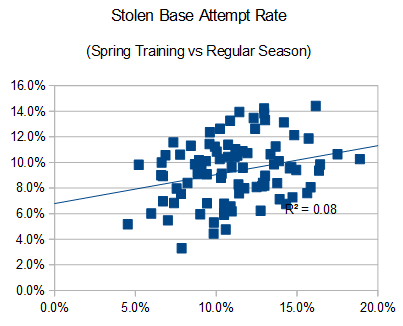Every season, I like to look at teams with new managers and see if their team's overall stolen-base attempts have changed. Last season, I found that new Cincinnati manager Bryan Price led Reds to doubling their number of attempted stolen bases. The biggest surprise was Todd Frazier and his 20 stolen bases, 10 more than he had combined the previous three seasons.
Today's statistical adventure looks to see if changes in spring training stolen-base attempts can indicate a regular-season change. While not every change is an indicator, teams that plan on running significantly more or less tend to show their regular-season plans in spring training.
I only believe in a few spring-training stats. I have been burned too many times following the hot hand and should have been looking for value elsewhere. Sometime this spring, I read/heard someone say they follow spring training stolen-base values to see if any players plan on stealing more. The light bulb went off, and here are results.
When looking at changes in stolen bases, I use stolen-bases attempts (SB + CS) divided by times on first bases (1B + BB). I don't like the raw attempts value because some teams might not have the opportunity to steal by striking out a bunch and/or getting extra-base hits. I know other runners could be on the bases impeding the runner with singles and walks, but it is a simple formula. While not perfect, it gives a sense of stolen-base chances per opportunity.
Going back to the
Every season, I like to look at teams with new managers and see if their team's overall stolen-base attempts have changed. Last season, I found that new Cincinnati manager Bryan Price led Reds to doubling their number of attempted stolen bases. The biggest surprise was Todd Frazier and his 20 stolen bases, 10 more than he had combined the previous three seasons.
Today's statistical adventure looks to see if changes in spring training stolen-base attempts can indicate a regular-season change. While not every change is an indicator, teams that plan on running significantly more or less tend to show their regular-season plans in spring training.
I only believe in a few spring-training stats. I have been burned too many times following the hot hand and should have been looking for value elsewhere. Sometime this spring, I read/heard someone say they follow spring training stolen-base values to see if any players plan on stealing more. The light bulb went off, and here are results.
When looking at changes in stolen bases, I use stolen-bases attempts (SB + CS) divided by times on first bases (1B + BB). I don't like the raw attempts value because some teams might not have the opportunity to steal by striking out a bunch and/or getting extra-base hits. I know other runners could be on the bases impeding the runner with singles and walks, but it is a simple formula. While not perfect, it gives a sense of stolen-base chances per opportunity.
Going back to the Reds, in 2013 they attempted a stolen base 6.8 percent of the time. In 2014 spring training, their attempt rate jumped to 13.0 percent and then climbed a bit more to 13.5 percent for the regular-season. The change was obvious in spring training, but it is a sample size of just one team. It's time to dig a little deeper.
Remember that the change might not be because of a change in philosophy, but talent. Billy Hamilton could have possibly explained the Reds' jump. In the article from last year, I removed him from the equation and there was still a noticeable jump.
To see if spring-training stats can be used, I took the 2012 to 2014 spring-training stats (as of Tuesday morning) and before and after full-season stolen-bases attempts. The median attempt rate was 9.7 percent for the full seasons and 10.9 percent for spring training. Teams are a little more liberal giving the green light during the spring.
Here is a graph with the R-squared compared the spring-training rate to that year's regular-season rate.

The correlation can sort of be seen, but an R-squared of 0.08 is not good.
Now here is the previous season's stolen base attempt rate compared to the current season.

A little more of a visible and actual correlation, but nothing to write home about. So previous season has more correlation to the next year's rate than this spring-training rate.
Time to look at the problem a little differently. I took the change in stolen bases from the previous season to spring training and ranked the differences. At the extremes, some conclusions can be made. In all cases when the attempt rate drop by at least 2 percentage points in spring training, the team's rate for the regular season dropped by an average of 3 percentage points. In 15 of the 16 cases where the rate increased, by 5 percentage points or more, the in-season rate increased by 2.5 percentage points on average. The high and low spring-training cutoff values are not uniform because of the higher spring training stolen-base rate.
Even though spring training is not over, here are the teams who could possibly see an increase or decrease in their stolen-base rate come the regular season.
Biggest Gainers
| TEAM | 2014 SEASON RATE | 2015 SPRING RATE | DIFFERENCE| Cardinals | 6.2 | 14.6 | +8.4 | Marlins | 5.3 | 12.8 | +7.5 | Angels | 8.2 | 15.3 | +7.2 | Pirates | 10.1 | 16.5 | +6.4 | Rays | 6.1 | 11.9 | +5.8 | Giants | 5.9 | 11.4 | +5.5 | |
Biggest Losers
| TEAM | 2014 SEASON RATE | 2015 TRAINING RATE | DIFFERENCE| Dodgers | 12.4 | 6.1 | -6.3 | Mets | 9.6 | 4.8 | -4.9 | Reds | 13.5 | 9.6 | -3.9 | Yankees | 10.0 | 6.3 | -3.7 | Astros | 11.4 | 9.2 | -2.2 | |
The real obvious changes is the drop in the Dodgers' stolen-base attempts and increase in the Marlins' values with Dee Gordon being traded to the Marlins from the Dodgers.
Here is a quick look at four of the teams with possible changes.
Dodgers - Was Dee Gordon only responsible for the drop?
This was fairly easy to rerun. With Gordon removed from the 2014 team, the attempt rate drops from 12.4 percent to 7.8 percent. While the team is seeing some drop, most of the decrease is from Gordon moving on.
Cardinals - Who is behind the increase?
Not one player is really taking off; this is an overall team effort. Stephen Piscottyis leading the charge with four attempts. It looks like Piscotty will start in Triple-A, but he could be a nice speed power guy if called up. Another player who could really see his value jump from more stolen bases is Kolten Wong. Last season, he had a combined 26 stolen bases between Triple-A and majors. Maybe he could see a boost into the 40s. Stay tuned.
Rays - New manger No. 1
Joe Maddon is out as the Rays manager and Rick Renteria is now in charge. The place for the biggest increase in stolen bases is in the outfield with Kevin Kiermaier and Steve Souza. Kiermaier has always been around 15 bags, but a jump to more than 20 with a full-time job would be nice. Souza stole 32 bases in 2013. It was 28 in in 2014. Our projections have him only at 12, so it might be time to move that number up. Way up.
Astros - New manager No. 2
Bo Porter is out with A.J. Hinch taking the reins in Houston. The Astros have seen a small decline, and the one player who could see fewer steals is Jose Altuve. His 56 stolen bases are expected to regress to only 50. I could see the number drop to about 30 and not be surprised one bit.
The team numbers could change a bit from now until Opening Day, but spring training stolen-bases attempts can help to shed some light on in-season intentions. At least we have an idea of which teams might give the green light this season and which ones might put on the breaks. While these chances shouldn't change a player's value too much, picking up a dozen or two extra stolen bases could be a huge bonus for a fantasy team.


























